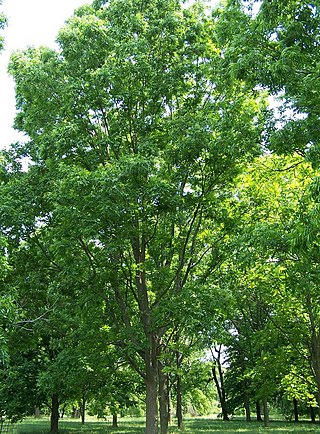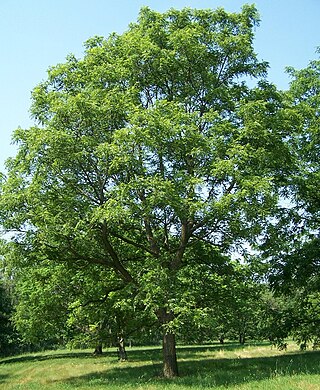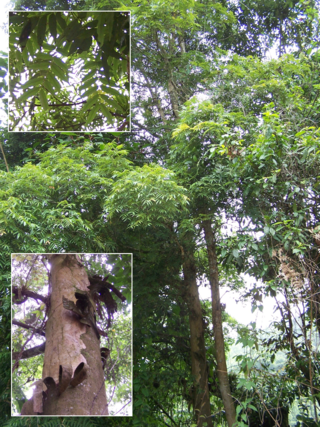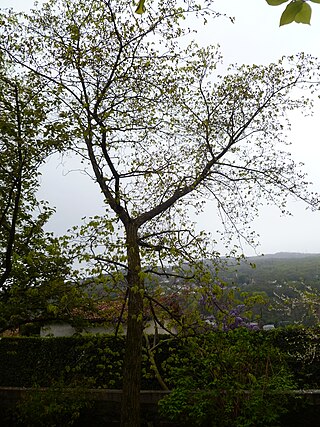
The Fagales are an order of flowering plants, including some of the best-known trees. The order name is derived from genus Fagus, beeches. They belong among the rosid group of dicotyledons. The families and genera currently included are as follows:
Family is one of the eight major hierarchical taxonomic ranks in Linnaean taxonomy. It is classified between order and genus. A family may be divided into subfamilies, which are intermediate ranks between the ranks of family and genus. The official family names are Latin in origin; however, popular names are often used: for example, walnut trees and hickory trees belong to the family Juglandaceae, but that family is commonly referred to as the "walnut family".

The pecan is a species of hickory native to the southern United States and northern Mexico in the region of the Mississippi River. The tree is cultivated for its seed primarily in the U.S. states of Georgia, New Mexico, and Texas, and in Mexico. The seed is an edible nut used as a snack and in various recipes, such as praline candy and pecan pie. The pecan is the state nut of Alabama, Arkansas, California, and Texas, and is also the state tree of Texas.
In biology, a tribe is a taxonomic rank above genus, but below family and subfamily. It is sometimes subdivided into subtribes. By convention, all taxonomic ranks from genus upwards are capitalized, including both tribe and subtribe.

The Juglandaceae are a plant family known as the walnut family. They are trees, or sometimes shrubs, in the order Fagales. Members of this family are native to the Americas, Eurasia, and Southeast Asia.

The Noctuidae, commonly known as owlet moths, cutworms or armyworms, are a family of moths. They are considered the most controversial family in the superfamily Noctuoidea because many of the clades are constantly changing, along with the other families of the Noctuoidea. It was considered the largest family in Lepidoptera for a long time, but after regrouping Lymantriinae, Catocalinae and Calpinae within the family Erebidae, the latter holds this title now. Currently, Noctuidae is the second largest family in Noctuoidea, with about 1,089 genera and 11,772 species. This classification is still contingent, as more changes continue to appear between Noctuidae and Erebidae.

Hickory is a common name for trees composing the genus Carya, which includes around 18 species. Five or six species are native to China, Indochina, and India (Assam), as many as twelve are native to the United States, four are found in Mexico, and two to four are native to Canada. A number of hickory species are used for products like edible nuts or wood.

The Orchidoideae, or the orchidoid orchids, are a subfamily of the orchid family (Orchidaceae) that contains around 3630 species. Species typically have a single (monandrous), fertile anther which is erect and basitonic.

Juglandeae is a tribe of the Juglandoideae subfamily, in the Juglandaceae family.

The Heliantheae are the third-largest tribe in the sunflower family (Asteraceae). With some 190 genera and nearly 2500 recognized species, only the tribes Senecioneae and Astereae are larger. The name is derived from the genus Helianthus, which is Greek for sun flower. Most genera and species are found in North America and South America. A few genera are pantropical.
Carya sinensis is a species of tree native to southwestern China and northern Vietnam, in the hickory genus Carya. It is sometimes called Chinese hickory or beaked hickory. It is closely related to Carya kweichowensis.

Platycarya is a genus of flowering plants in the family Juglandaceae native to eastern Asia in China, Korea, and Japan.

Oreomunnea mexicana is a species of plant in the family Juglandaceae, which grows in the tropical rain forests of Mexico, Guatemala, Nicaragua, Costa Rica, and Panama at altitudes from 1–1.7 km. Common names include guayabo amarillo and remiendo. The chromosome number is 2n = 32.

The Vandeae is a large monophyletic tribe within the family of orchids.

Juglandoideae is a subfamily of the walnut family Juglandaceae.

Platycaryeae is a tribe of flowering plants in the family Juglandaceae, and comprising a single living genus Platycarya. The tribe is now native to eastern Asia in China, Korea, and Japan.

Juglandinae is a subtribe of the Juglandeae tribe, of the Juglandoideae subfamily, in the Juglandaceae family. Walnut tree species make up the genus Juglans, which belongs to the subtribe Juglandinae.

Rauvolfioideae is a subfamily of the flowering plant family Apocynaceae. Many species are woody lianas, others are shrubs or perennial herbs.

The Euchromiina are a subtribe of tiger moths in the family Erebidae. It was described by Arthur Gardiner Butler in 1876. Many species in the subtribe are mimics of wasps. Euchromiina have always been considered closely related to the subtribe Ctenuchina due to their similarity to moths and wasps. These two subtribes make up around 3,000 valid species, the majority of which occur in the Neotropics.














